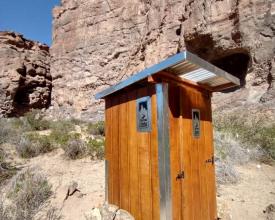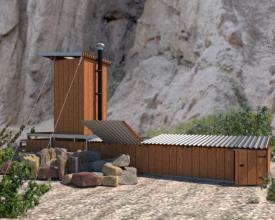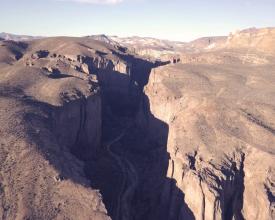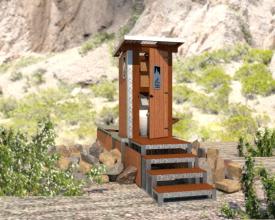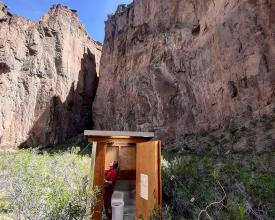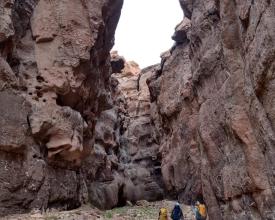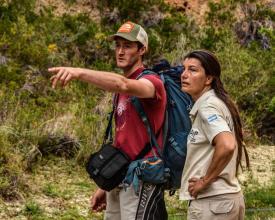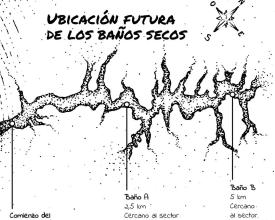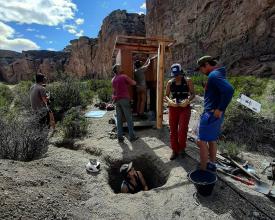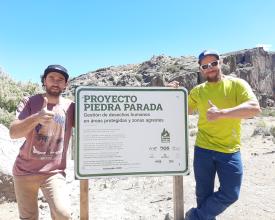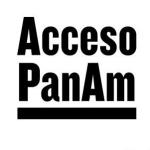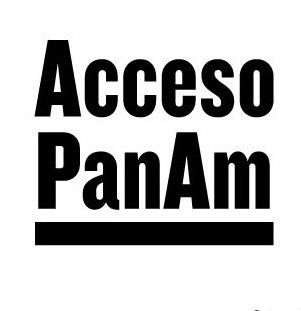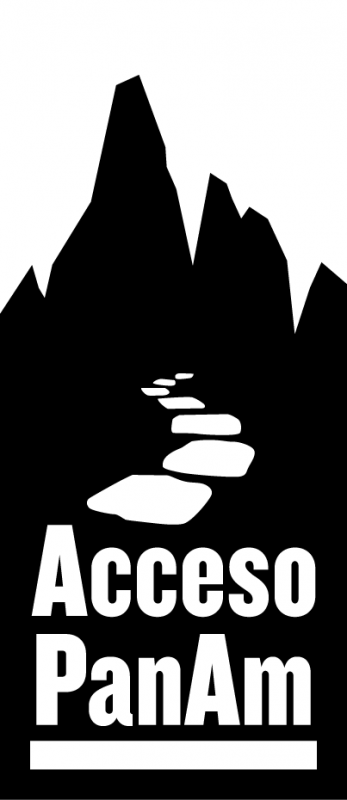
Human waste management in the Piedra Parada Natural Protected Area, Chubut, Argentina
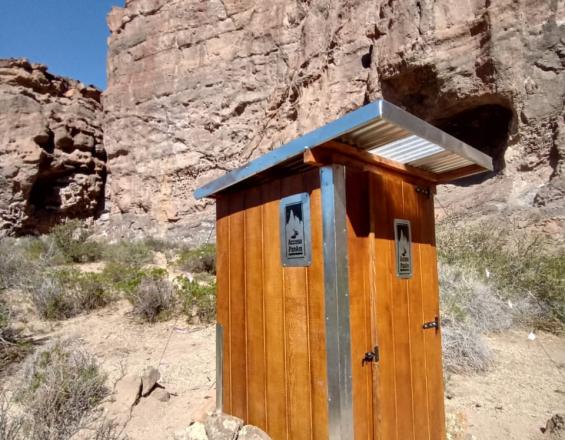
Acceso PanAm's conservation program has four components that connect people and mountains: (a) support for better protected area management; (b) community engagement and stewardship; (c) citizen science; and (d) public policy advocacy.
This specific project addresses certain issues in the Piedra Parada Natural Protected Area (Piedra Parada NPA), a provincial park in Argentinean Patagonia by proposing solutions to manage human waste in wilderness areas and involve the local community in the management of the Natural Protected Area through the construction of two dry toilets within the Piedra Parada NPA boundaries and understanding the local context.
The applied result was a simple and economical option to manage waste in a wild and remote location, provide a healthier human experience in the region, as well as an improvement for the local environment.
Context
Challenges addressed
The number of tourists is increasing. Piedra Parada PNA receives more than 10,000 visitors per year, with the months of December to February being the months with the highest concentration of tourists.
The ANP has a great diversity of fauna, with a total of 65 sp of birds, 15 sp of mammals and at least 4 sp of reptiles identified. As people break into the ecosystem of the place, there are situations of exposure to risks of infections transmitted by human feces not properly managed and that are left on the vegetation, exposed to be ingested by rodents that are then preyed upon by birds of prey. It can also infect foxes, wild cats or pumas, as there are many diseases that humans transmit to their domestic relatives, dogs and cats.
Currently, the Piedra Parada Natural Protected Area is a provincial protected area and lacks sufficient economic resources to manage the entire area.
Location
Process
Summary of the process
The 5 building blocks constitute the pillars of the solution to the problem of human waste in the Piedra Parada protected natural area. These are different phases and actions that lead to the development of a concrete response. Different factors and key actors interact in a coordinated manner to find a solution. Government authorities, experts and volunteers act synergistically, forming a multidisciplinary network that carries out diagnostic actions, network generation, solution implementation, monitoring and eventual adjustments. The result is a successful project with the potential to be replicated in other natural areas. The management of human waste is of utmost importance both for health reasons and in terms of coexistence with the natural environment.
Building Blocks
Environmental problem analysis and planning
Compilation of information on the protected area's ecosystem, geographic, social, and environmental characteristics relevant to the issue.
Development of a management plan for human waste that reduces the impact on the flora and fauna of the site and improves the visitor experience.
Enabling factors
To have a multidisciplinary technical team and material resources for the study campaign.
Lesson learned
It is very important to define specific roles for each task, make a schedule of activities, set short and long term goals and objectives.
Presentation to the Natural Protected Area
Establish contact with the institutions in charge of managing the protected area to discuss the problem and the proposed solution.
Agree on the signing of a bilateral agreement for the implementation of the project and its continuity.
Enabling factors
Good communication with the provincial authorities in charge of the protected area.
Availability of financial resources for project implementation.
Lesson learned
Lack of government resources to carry out some project activities and their continuity over time. In order to solve this problem, it is necessary to obtain support from external resources and promote community involvement.
Generation of alliances and search for economic resources
Actions that generate the commitment of all relevant stakeholders in the development of the project (project executing organization, protected area authorities, local communities, visitors, business sector).
Seek funding from different sources (international cooperation, private donors, governments, etc.).
Enabling factors
Adequately communicate the problem to be solved and its importance to keep stakeholders involved in the project.
Availability of fundraising resources. Interest of funders in the conservation of protected areas.
Lesson learned
Funding is one of the key factors for the solution to be implemented and for it to be replicated in this and other areas.
Solution implementation
For the implementation of the solution it is necessary to build dry toilets by means of a portable system of panels that can be easily transported to remote and difficult to access sites. Generating the least possible impact to the natural area. The installation of the same is done efficiently and adapting to the climatic conditions that in mountain ecosystems such as this, are not always favorable.
Enabling factors
Availability of means of transportation for materials.
Coordination of work teams.
Sustainable and durable construction system.
Lesson learned
The importance of working with volunteers.
The support of local authorities and communities.
Monitoring and maintenance
Training for the maintenance and proper operation of the restrooms.
Gathering feedback from users to improve the units.
Monitoring of the solution and the ecosystem's response, together with the protected area authorities and the project's technical team.
Proposals for technological improvements to the units based on the monitoring results.
Enabling factors
Availability of a technical team, volunteers and support from park rangers.
Availability of users in the use of the solution.
Lesson learned
The importance of keeping up to date on dry toilets technology and construction materials to implement continuous and effective improvements. In order to improve biodiversity and protect environments that are continuously growing in their flow of visitors.
Impacts
The installation of dry toilets in the area has led to an improvement in the management of human feces, since the area near the dry toilets in sectors used as wild toilets has been significantly reduced, not only reducing exposed human feces but also the presence of toilet paper, towels, and other personal hygiene items.
The provision of dry toilets not only reduces the risk of infections for local fauna and visitors, but also improves landscape care due to the reduction of personal hygiene items scattered in the areas used as wild toilets.
This improves the environmental management of the protected area and its biodiversity, cooperating and facilitating the work of the park rangers and helping the community to take advantage of the ecosystem and reduce negative impacts.
Beneficiaries
The provision of dry toilets reduces the risk of infection for local fauna and visitors, and also improves the environmental management of the protected area, facilitating the work of the park rangers and benefiting the community.
Sustainable Development Goals
Story
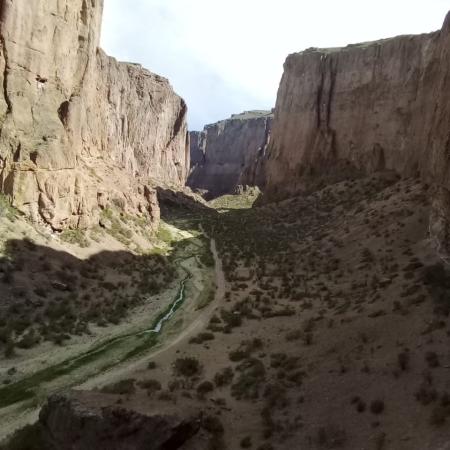
Acceso PanAm (APA) is an international non-profit organization created in 2009 that is dedicated to preserving and maintaining open access to climbing and mountaineering areas in Latin America.
For three days in August 2009, under the granite walls of Squamish, British Columbia in Canada, open access activists from Brazil, Chile, Mexico, Canada and the United States met to talk and discuss the problems faced by climbers throughout the Americas. This meeting was sponsored by the Petzl Foundation and supported by the Squamish Mountain Festival.
As a result, Acceso PanAm (APA) was born from an effort of climbers, climbing organizations and federations, outdoor-related clubs, and the interested business sector.
To ensure free access and protection of climbing and mountaineering environments, APA uses a variety of strategies including direct action in Brazil, Peru, Chile and Argentina and empowerment of local climbing organizations in other countries. Acceso PanAm's mission is to protect access to climbing and mountaineering areas in Latin America and to promote their conservation. To this end, we work in the following areas:
Advocacy: Acceso PanAm works to influence, impact and influence public policy and legislation affecting climbing and mountaineering.
Conservation: Acceso PanAm protects mountain ecosystems through conservation actions, volunteer projects and support in the planning and management of protected areas, mountaineering and climbing areas in Latin America.
Negotiation: Acceso PanAm negotiates access to climbing areas by supporting landowners and managers in the planning, management of climbing, mountaineering and other activities.
Training: Acceso PanAm encourages and supports local organizations fighting for access to climbing areas and climbers to carry out conservation initiatives, providing them with training and advice for these interventions.
interventions.
Outreach and education: Acceso PanAm is committed to generating instances of reflection and education for the climbing community, owners and managers about climbing culture and the importance of conserving mountains through programs, campaigns, events, educational materials and partnerships.

